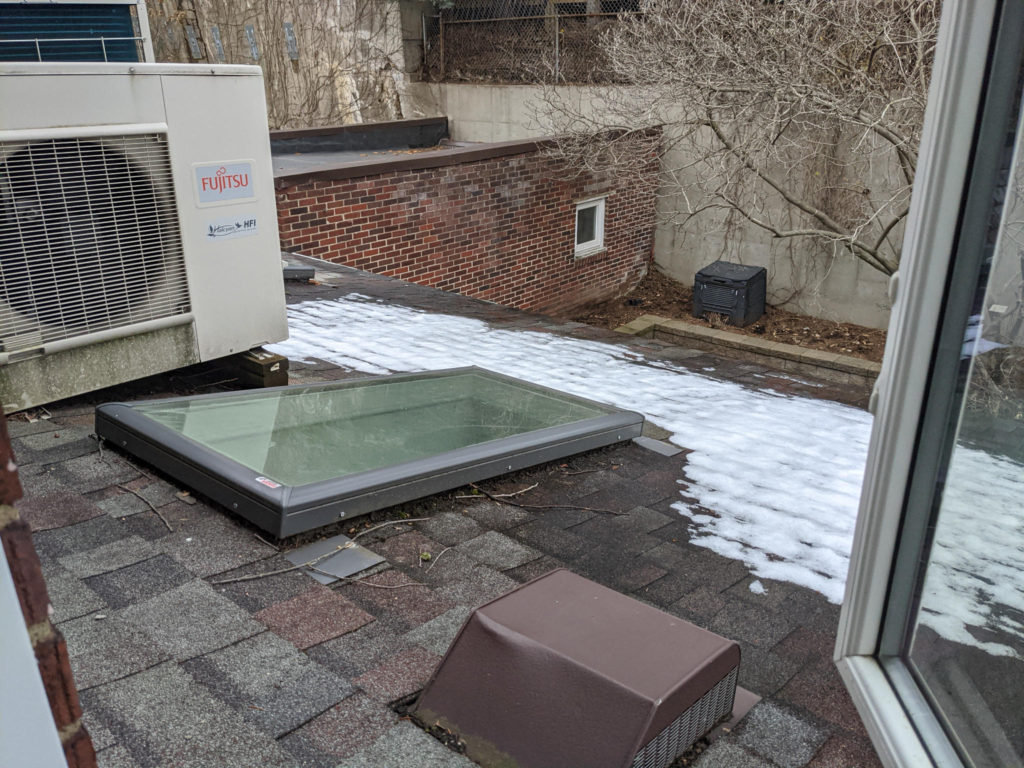Back in November 2020, we stopped using gas for heat and switched to heat pumps. Here’s our story.
TL;DR: Don’t put your heat pump on your roof.
We switched to heat pumps because our old gas furnace couldn’t control the inside temperature. It was a hot-water heating system, and badly designed: the upstairs thermostat and the upstairs radiators were in different rooms. The thermostat was in the hallway, and the radiators were in the bedrooms, and if you closed the bedroom door on a cold night, the hallway would get cold, which would make the furnace turn on. Then I’d wake up sweating, fighting off dreams of the Sahara.
And, also, we switched because of the climate crisis. Heat pumps have gotten a lot better recently: these days they run down to -13°F (-25C), and Pittsburgh never gets quite that cold. [Last I checked, Fujitsu has the XLTH low temperature heating series and Mitsubishi has the Hyper-Heating H2I series. Maybe other companies. now.] Anywhere south of Chicago, heat pumps will keep your house warm and will have a smaller carbon footprint than gas heat, so they are a good thing.
When, we installed our first heat pump in late 2013, we were a bit clueless. We’d just moved to Pittsburgh and didn’t really understand that polar vortexes will occasionally push the temperature down below zero, so we saved a few $$ by installing the 5°F version of the heat pump, instead of the -13°F version. We had it installed on the back roof, replacing an old air conditioner.
This was a Fujitsu mini-split unit, and it worked well, though it was installed messily with left refrigerant pipes wandering through the air between the indoor and outdoor units. But messy or not, it worked, even when the 2015 polar vortex hit and brought the air temperature down to -10°F. At that temperature, the pump worked really hard. It was humming away on the roof; humming hard enough that fingertips on the wall could feel a faint vibration, but still it pumped heat beyond expectations. So, we liked it.
We installed a second heat pump for the front of the house, which is fine. And, we also installed a third pump: our lemon. We don’t know if it was bad from the factory or badly installed [the technician who did the wandering pipes installed our lemon], but it failed twice: both times in the middle of the winter.
And [in case you didn’t guess] it’s really hard to get a HVAC technician to come out on a week when the temperature’s below freezing and to walk across an snowy roof to get to your malfunctioning heat pump. And [in case you didn’t guess] both times, the heat pump failed on the first really cold week of the winter.
But it wasn’t so bad because we had three small heat pumps instead of one big one. We kept the doors open and ran the neighboring rooms a little bit hotter. It was sweater weather in two rooms, and summertime in the rest of the house.

So, it worked, but did we learn anything? I think so:
- Two (or three) small heat pumps are better than one big one. Heat pumps are very reliable, but in case yours fails, you don’t want your pipes to freeze.
- Don’t put your heat pumps on a roof, even if it’s a nice gentle roof that’s not too high up. For some reason, HVAC technicians have strong opinions about roofs, frozen fingers, and especially the combination of both.
- Mini-split air-source hat pumps can handle Pittsburgh weather.
Is it cheaper than gas? I’m sorry to say we don’t really know. In the four years between installing our first heat pump and our last one, the price of gas changed, and we added some weather stripping, insulation, and solar panels to the house.
What about the installation cost? That’s complicated:
- We were running a 40 year-old furnace; it was going to need replacement anyway.
- We now have an 8-zone system that keeps every room at a nice temperature, instead of the old two-zone system with thermostats in the wrong rooms.
- Heat pumps are excellent air conditioners in the summer: we don’t need window air conditioners.
- We got eight extra square feet of extra floor space by taking out a radiator, and we can take out several more radiators if we want to.